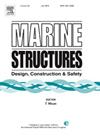TMD suppresses 2-DOF vortex-induced vibration of a cylinder
IF 4
2区 工程技术
Q1 ENGINEERING, CIVIL
引用次数: 0
Abstract
Due to its simple structure, low cost, and convenient installation, using a Tuned Mass Damper (TMD) to suppress cylindrical vortex-induced vibration has good prospects. However, there are few literature reports on this aspect, so this paper uses TMD to suppress the 2-DOF vortex induced vibration of a cylinder based on the wake oscillator (Reynolds number Re=300∼1.5 × 105). The theoretical equation for the bidirectional fluid-structure coupling vibration composed of TMD and cylinder is established. Then, numerical methods were used to verify the bidirectional vortex-induced vibration of the cylinder. Finally, the effects of TMD mass and damping on the amplitude, drag, Lift, and trajectory changes of vortex-induced vibration of a cylinder at different reduced velocities were studied. The results show that TMD effectively reduces the vibration amplitude of cylindrical vortex-induced vibration based on wake oscillators in most reduced velocity ranges. Under certain operating conditions, TMD cannot control the vortex-induced vibration of the cylinder, and even increases the amplitude of the vortex-induced vibration, providing the possibility of capturing the energy generated by the motion of the cylinder for power generation. The drag and lift coefficient curves change drastically from single or double-wave peaks to three or four-wave peaks. When the reduced velocity is (6, 9), TMD reduces cylindrical vortex-induced vibration's amplitude and displacement trajectory, decreasing 23.56 % to 82.41 % in the X and Y directions.
TMD抑制了圆柱体的二自由度涡激振动
采用调谐质量阻尼器抑制圆柱涡激振动具有结构简单、成本低、安装方便等优点,具有良好的应用前景。然而,这方面的文献报道很少,因此本文采用TMD来抑制基于尾流振荡器(雷诺数Re=300 ~ 1.5 × 105)的圆柱体的二自由度涡激振动。建立了由TMD和气缸组成的双向流固耦合振动的理论方程。然后,采用数值方法验证了圆柱的双向涡激振动。最后,研究了TMD质量和阻尼对不同降速下圆柱涡激振动幅值、阻力、升力和轨迹变化的影响。结果表明,TMD在大多数减小速度范围内有效地减小了基于尾流振子的圆柱涡激振动的振动幅值。在一定的运行条件下,TMD无法控制气缸的涡激振动,甚至会增大涡激振动的幅值,从而为捕获气缸运动产生的能量进行发电提供了可能。阻力和升力系数曲线从单波或双波峰值到三波或四波峰值变化剧烈。当减小速度为(6,9)时,TMD减小了圆柱涡激振动的振幅和位移轨迹,在X和Y方向上减小了23.56% ~ 82.41%。
本文章由计算机程序翻译,如有差异,请以英文原文为准。
求助全文
约1分钟内获得全文
求助全文
来源期刊

Marine Structures
工程技术-工程:海洋
CiteScore
8.70
自引率
7.70%
发文量
157
审稿时长
6.4 months
期刊介绍:
This journal aims to provide a medium for presentation and discussion of the latest developments in research, design, fabrication and in-service experience relating to marine structures, i.e., all structures of steel, concrete, light alloy or composite construction having an interface with the sea, including ships, fixed and mobile offshore platforms, submarine and submersibles, pipelines, subsea systems for shallow and deep ocean operations and coastal structures such as piers.
 求助内容:
求助内容: 应助结果提醒方式:
应助结果提醒方式:


